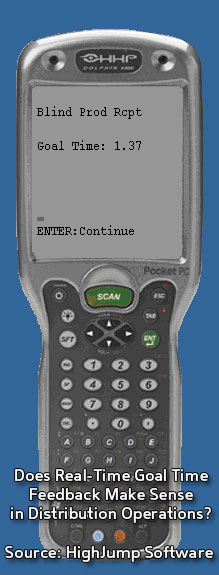 Maybe, according to Jim LeTart of RedPrairie, a long-time provider of LMS systems, who says logistics managers are increasingly interested in operators having this kind of real-time feedback. Maybe, according to Jim LeTart of RedPrairie, a long-time provider of LMS systems, who says logistics managers are increasingly interested in operators having this kind of real-time feedback.
“The benefit of providing feedback real-time is to make the workers feel empowered to control their work-rate and perhaps bonus,” LeTart said.
But, he says, it’s still not for everyone.
“When to provide feedback is really a customer decision,” LeTart told SCDigest. “We have some who provide it real-time via RF. Others post it on boards in the DC. Still others make it available via monitors in break rooms. Some only provide this info on a daily or weekly basis.”
Chad Collins of HighJump Software has a similar perpsective.
“In my view, real-time performance feedback is a valuable feature, provided that standards are accurate and maintained over time,” Collins says. He says that about half of HighJump’s LMS customers use such real-time feedback capabilities at some level.
Steve Johnson, a principal at consulting firm Johnson Stephens Consulting in Atlanta, sees the benefits of real-time feedback, but agrees that adoption of the practice to date is still low.
“LMS feedback to RF and Voice users offers the best opportunity yet to realize further productivity gains right at the point of work,” Johnson told SCDigest.
He adds: “LMS providers are working to provide this as part of their solutions. We estimate that an additional 12 to 18% productivity improvement can be realized just from being able to feed back “the score” to associates, literally as they are doing the work.”
But, he says some companies feel real-time feedback can be a distraction and can actually dis-incent workers who will gear back to just 100% when they could do more, especially if there is no incentive for over-quota performance.
Peter Schnorbach of LMS provider Manhattan Association says the benefits of real-time feedback may be application-specific.
“I think real-time performance feedback may be most applicable in a piece/carton pick area where there is a fair amount of time involved in operator foot travel and actual selection activity,” Schnorbach says. “For people riding around on forklifts or working at a station, the job becomes more a function of the machine timing and, therefore, instantaneous feedback is less important.”
Our view: while it seems that relatively few companies actually use real-time performance LMS feedback currently, the trend is moving this way, and will become commonplace in the next 3-5 years.
What is your opinion on real-time LMS feedback? Do you have actual experience pro or con? Let us know your thoughts at the Feedback button below.
SCDigest is Twittering!
Follow us now at https://twitter.com/scdigest |